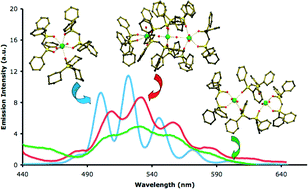We describe the synthesis, solid state and solution properties of two families of uranyl(VI) complexes that are ligated by neutral monodentate and anionic bidentate P![[double bond, length as m-dash]](https://www.rsc.org/images/entities/char_e001.gif) O, P
O, P![[double bond, length as m-dash]](https://www.rsc.org/images/entities/char_e001.gif) NH and As
NH and As![[double bond, length as m-dash]](https://www.rsc.org/images/entities/char_e001.gif) O ligands bearing pendent phenyl chromophores. The uranyl(VI) ions in these complexes possess long-lived photoluminescent LMCT 3Πu excited states, which can be exploited as a sensitive probe of electronic structure, bonding and aggregation behaviour in non-aqueous media. For a family of well defined complexes of given symmetry in trans-[UO2Cl2(L2)] (L = Ph3PO (1), Ph3AsO (2) and Ph3PNH (3)), the emission spectral profiles in CH2Cl2 are indicative of the strength of the donor atoms bound in the equatorial plane and the uranyl bond strength; the uranyl LMCT emission maxima are shifted to lower energy as the donor strength of L increases. The luminescence lifetimes in fluid solution mirror these observations (0.87–3.46 μs) and are particularly sensitive to vibrational and bimolecular deactivation. In a family of structurally well defined complexes of the related anion, tetraphenylimidodiphosphinate (TPIP), monometallic complexes, [UO2(TPIP)(thf)] (4), [UO2(TPIP)(Cy3PO)] 5), a bimetallic complex [UO2(TPIP)2]2 (6) and a previously known trimetallic complex, [UO2(TPIP)2]3 (7) can be isolated by variation of the synthetic procedure. Complex 7 differs from 6 as the central uranyl ion in 7 is orthogonally connected to the two peripheral ones viauranyl → uranium dative bonds. Each of these oligomers exhibits a characteristic optical fingerprint, where the emission maxima, the spectral shape and temporal decay profiles are unique for each structural form. Notably, excited state intermetallic quenching in the trimetallic complex 7 considerably reduces the luminescence lifetime with respect to the monometallic counterpart 5 (from 2.00 μs to 1.04 μs). This study demonstrates that time resolved and multi-parametric luminescence can be of value in ascertaining solution and structural forms of discrete uranyl(VI) complexes in non-aqueous solution.
O ligands bearing pendent phenyl chromophores. The uranyl(VI) ions in these complexes possess long-lived photoluminescent LMCT 3Πu excited states, which can be exploited as a sensitive probe of electronic structure, bonding and aggregation behaviour in non-aqueous media. For a family of well defined complexes of given symmetry in trans-[UO2Cl2(L2)] (L = Ph3PO (1), Ph3AsO (2) and Ph3PNH (3)), the emission spectral profiles in CH2Cl2 are indicative of the strength of the donor atoms bound in the equatorial plane and the uranyl bond strength; the uranyl LMCT emission maxima are shifted to lower energy as the donor strength of L increases. The luminescence lifetimes in fluid solution mirror these observations (0.87–3.46 μs) and are particularly sensitive to vibrational and bimolecular deactivation. In a family of structurally well defined complexes of the related anion, tetraphenylimidodiphosphinate (TPIP), monometallic complexes, [UO2(TPIP)(thf)] (4), [UO2(TPIP)(Cy3PO)] 5), a bimetallic complex [UO2(TPIP)2]2 (6) and a previously known trimetallic complex, [UO2(TPIP)2]3 (7) can be isolated by variation of the synthetic procedure. Complex 7 differs from 6 as the central uranyl ion in 7 is orthogonally connected to the two peripheral ones viauranyl → uranium dative bonds. Each of these oligomers exhibits a characteristic optical fingerprint, where the emission maxima, the spectral shape and temporal decay profiles are unique for each structural form. Notably, excited state intermetallic quenching in the trimetallic complex 7 considerably reduces the luminescence lifetime with respect to the monometallic counterpart 5 (from 2.00 μs to 1.04 μs). This study demonstrates that time resolved and multi-parametric luminescence can be of value in ascertaining solution and structural forms of discrete uranyl(VI) complexes in non-aqueous solution.

You have access to this article
 Please wait while we load your content...
Something went wrong. Try again?
Please wait while we load your content...
Something went wrong. Try again?
![[double bond, length as m-dash]](https://www.rsc.org/images/entities/char_e001.gif) O, P
O, P![[double bond, length as m-dash]](https://www.rsc.org/images/entities/char_e001.gif) NH and As
NH and As![[double bond, length as m-dash]](https://www.rsc.org/images/entities/char_e001.gif) O
O 

 Please wait while we load your content...
Please wait while we load your content...